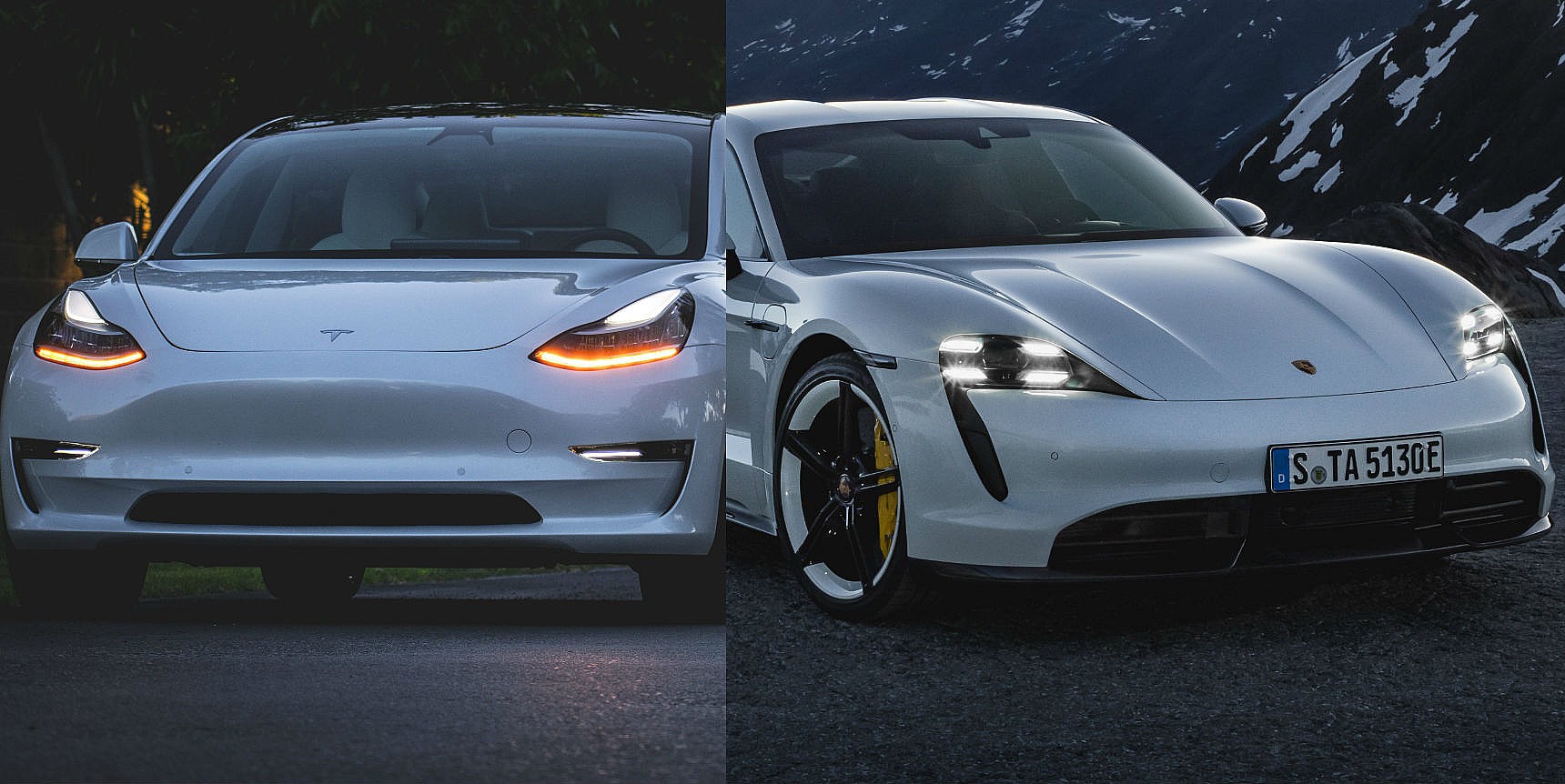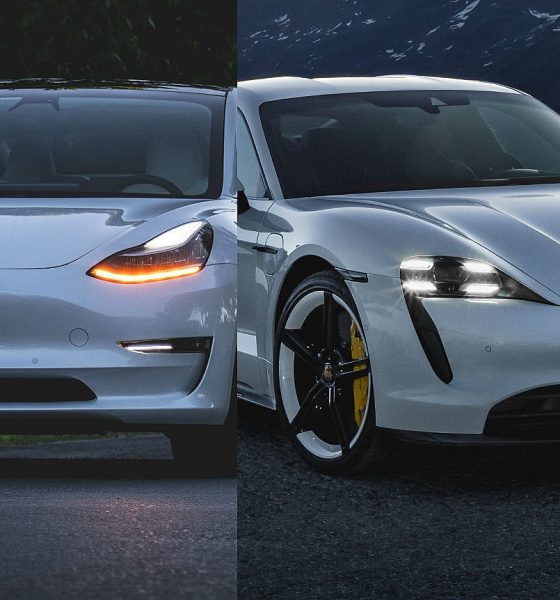The Porsche Taycan is an uncompromising electric sports sedan. Built on a platform designed specifically for EVs and tapping into electric motor tech that powered past flagship vehicles like the 918 Spyder, the Taycan represents the best of what Porsche can offer today, in an unapologetically electric package.
It is then unsurprising to see that with the Taycan’s arrival, the long-debunked narrative of the “Tesla Killer” was reborn. American online auto information resource Edmunds, for one, proudly declared in a tweet that after experiencing the Taycan that its team “got out with a singular thought: This is a Tesla Killer.” The company then proceeded to state that the Taycan has a “driving ability that no Tesla can match,” especially considering that its track-capable and its optimal 0-60 mph launches could be repeated “endlessly.”
While statements such as these foster both healthy and unhealthy debates among the EV and auto community, it is pertinent to highlight the simple fact that the Taycan is NOT a “Tesla Killer.” Instead, it could very well be the first genuine attempt from an experienced premium automaker to design and release an electric vehicle that is, in more ways than one, a potential “killer” of the internal combustion engine. This makes the Taycan the strongest vehicle yet that could accompany Tesla in Elon Musk’s overall plan to transition the transportation sector away from fossil fuels.
The Taycan, particularly the Turbo S variant, is an honest-to-goodness driver’s car. The German automaker made it clear that when it was designing the vehicle, it made sure that the “soul” that is so valued among the traditional car community is present in the electric four-door sedan. This is evident in the way the company tuned the driving dynamics of the car, which was tuned in the Nurburgring. The Taycan is just like any other Porsche: it’s the type of car that you take up to the mountains on a weekend drive. It just happens to be electric.
During its Annual Press Conference earlier this year, Porsche emphasized how the Taycan is the start of its own transition to a full embrace of electric mobility. The company’s executives acknowledged that more electric vehicles are coming, and it is transitioning its fleet as much as possible to do so. Porsche is serious enough in this initiative that it quite literally changed the face of its historic Zuffenhausen factory to make way for the Taycan and its other upcoming electric cars.
Perhaps what really makes the Taycan a compelling vehicle is the fact that unlike other EVs from veteran carmakers that have come before it, the four-door is not an exercise in compromise. It represents a real effort by an experienced automaker to release an EV that is superior to some of its own ICE-powered creations. A look at the vehicle’s specs shows that apart from its range, which is still far from Tesla’s level, the Taycan is a solid electric car. It could even be stated that with the Taycan’s arrival, it would be pretty silly to choose an equally-priced high-performance car with an internal combustion engine.
Elon Musk has always stated that Tesla’s mission is to accelerate the transition of the auto industry towards sustainability. The company has so far been able to accomplish this by introducing vehicles like the Model S and Model 3, both of which are simply better than the available competition. Yet Musk has also been honest about his belief that Tesla could not push the auto industry towards sustainability alone. It needs other automakers to join the fray by offering excellent electric vehicles that beat out gas cars in key metrics. The Taycan could very well be the first in this list.
Tesla has long been a polarizing company, and it will likely continue to be polarizing for years to come. Regardless of how successful the company gets, or how well vehicles like the Model 3 and Model S perform on the market, there will always be car buyers that will refuse to purchase one of its vehicles based on one reason or another. Accelerating the world’s transition to sustainability is a mass effort, and the auto industry would need a lot more vehicles like the Porsche Taycan to accomplish this.
Overall, could the Taycan potentially steal some customers from Tesla’s higher-priced vehicles like the 345-mile, ~$100,000 Model S Performance? Perhaps, if buyers are in the market for a ~$150,000 car that drives like a classic Porsche, and if they are more open to a high-performance EV with 279 miles of range (under the WLTP standard) and less interior space. But will the Taycan affect the Model 3 in any way? Absolutely not.

Elon Musk
Elon Musk and Tesla AI Director share insights after empty driver seat Robotaxi rides
The executives’ unoccupied tests hint at the rapid progress of Tesla’s unsupervised Robotaxi efforts.

Tesla CEO Elon Musk and AI Director Ashok Elluswamy celebrated Christmas Eve by sharing personal experiences with Robotaxi vehicles that had no safety monitor or occupant in the driver’s seat. Musk described the system’s “perfect driving” around Austin, while Elluswamy posted video from the back seat, calling it “an amazing experience.”
The executives’ unoccupied tests hint at the rapid progress of Tesla’s unsupervised Robotaxi efforts.
Elon and Ashok’s firsthand Robotaxi insights
Prior to Musk and the Tesla AI Director’s posts, sightings of unmanned Teslas navigating public roads were widely shared on social media. One such vehicle was spotted in Austin, Texas, which Elon Musk acknowleged by stating that “Testing is underway with no occupants in the car.”
Based on his Christmas Eve post, Musk seemed to have tested an unmanned Tesla himself. “A Tesla with no safety monitor in the car and me sitting in the passenger seat took me all around Austin on Sunday with perfect driving,” Musk wrote in his post.
Elluswamy responded with a 2-minute video showing himself in the rear of an unmanned Tesla. The video featured the vehicle’s empty front seats, as well as its smooth handling through real-world traffic. He captioned his video with the words, “It’s an amazing experience!”
Towards Unsupervised operations
During an xAI Hackathon earlier this month, Elon Musk mentioned that Tesla owed be removing Safety Monitors from its Robotaxis in Austin in just three weeks. “Unsupervised is pretty much solved at this point. So there will be Tesla Robotaxis operating in Austin with no one in them. Not even anyone in the passenger seat in about three weeks,” he said. Musk echoed similar estimates at the 2025 Annual Shareholder Meeting and the Q3 2025 earnings call.
Considering the insights that were posted Musk and Elluswamy, it does appear that Tesla is working hard towards operating its Robotaxis with no safety monitors. This is quite impressive considering that the service was launched just earlier this year.
Elon Musk
Starlink passes 9 million active customers just weeks after hitting 8 million
The milestone highlights the accelerating growth of Starlink, which has now been adding over 20,000 new users per day.

SpaceX’s Starlink satellite internet service has continued its rapid global expansion, surpassing 9 million active customers just weeks after crossing the 8 million mark.
The milestone highlights the accelerating growth of Starlink, which has now been adding over 20,000 new users per day.
9 million customers
In a post on X, SpaceX stated that Starlink now serves over 9 million active users across 155 countries, territories, and markets. The company reached 8 million customers in early November, meaning it added roughly 1 million subscribers in under seven weeks, or about 21,275 new users on average per day.
“Starlink is connecting more than 9M active customers with high-speed internet across 155 countries, territories, and many other markets,” Starlink wrote in a post on its official X account. SpaceX President Gwynne Shotwell also celebrated the milestone on X. “A huge thank you to all of our customers and congrats to the Starlink team for such an incredible product,” she wrote.
That growth rate reflects both rising demand for broadband in underserved regions and Starlink’s expanding satellite constellation, which now includes more than 9,000 low-Earth-orbit satellites designed to deliver high-speed, low-latency internet worldwide.
Starlink’s momentum
Starlink’s momentum has been building up. SpaceX reported 4.6 million Starlink customers in December 2024, followed by 7 million by August 2025, and 8 million customers in November. Independent data also suggests Starlink usage is rising sharply, with Cloudflare reporting that global web traffic from Starlink users more than doubled in 2025, as noted in an Insider report.
Starlink’s momentum is increasingly tied to SpaceX’s broader financial outlook. Elon Musk has said the satellite network is “by far” the company’s largest revenue driver, and reports suggest SpaceX may be positioning itself for an initial public offering as soon as next year, with valuations estimated as high as $1.5 trillion. Musk has also suggested in the past that Starlink could have its own IPO in the future.
News
NVIDIA Director of Robotics: Tesla FSD v14 is the first AI to pass the “Physical Turing Test”
After testing FSD v14, Fan stated that his experience with FSD felt magical at first, but it soon started to feel like a routine.

NVIDIA Director of Robotics Jim Fan has praised Tesla’s Full Self-Driving (Supervised) v14 as the first AI to pass what he described as a “Physical Turing Test.”
After testing FSD v14, Fan stated that his experience with FSD felt magical at first, but it soon started to feel like a routine. And just like smartphones today, removing it now would “actively hurt.”
Jim Fan’s hands-on FSD v14 impressions
Fan, a leading researcher in embodied AI who is currently solving Physical AI at NVIDIA and spearheading the company’s Project GR00T initiative, noted that he actually was late to the Tesla game. He was, however, one of the first to try out FSD v14.
“I was very late to own a Tesla but among the earliest to try out FSD v14. It’s perhaps the first time I experience an AI that passes the Physical Turing Test: after a long day at work, you press a button, lay back, and couldn’t tell if a neural net or a human drove you home,” Fan wrote in a post on X.
Fan added: “Despite knowing exactly how robot learning works, I still find it magical watching the steering wheel turn by itself. First it feels surreal, next it becomes routine. Then, like the smartphone, taking it away actively hurts. This is how humanity gets rewired and glued to god-like technologies.”
The Physical Turing Test
The original Turing Test was conceived by Alan Turing in 1950, and it was aimed at determining if a machine could exhibit behavior that is equivalent to or indistinguishable from a human. By focusing on text-based conversations, the original Turing Test set a high bar for natural language processing and machine learning.
This test has been passed by today’s large language models. However, the capability to converse in a humanlike manner is a completely different challenge from performing real-world problem-solving or physical interactions. Thus, Fan introduced the Physical Turing Test, which challenges AI systems to demonstrate intelligence through physical actions.
Based on Fan’s comments, Tesla has demonstrated these intelligent physical actions with FSD v14. Elon Musk agreed with the NVIDIA executive, stating in a post on X that with FSD v14, “you can sense the sentience maturing.” Musk also praised Tesla AI, calling it the best “real-world AI” today.










